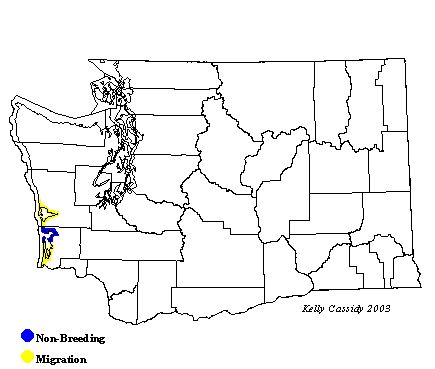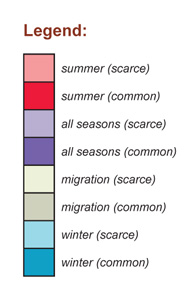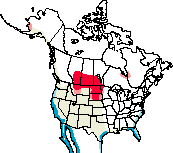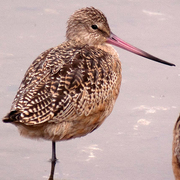Marbled Godwit
General Description
Marbled Godwits are large shorebirds with slightly upturned bills. They are mottled brown with cinnamon underwings that are distinctive in flight. In winter, they are plain underneath, but during the breeding season they have dark barring on their breasts and bellies.
Habitat
They nest in native prairie habitats: wet meadows and grassy areas near water. During migration and winter, they are coastal, foraging on mudflats, salt marshes, estuaries, and coastal pools.
Behavior
Marbled Godwits are commonly seen in flocks with Whimbrels and Long-billed Curlews, both large and brown like the Marbled Godwit. The Marbled Godwit moves slowly, probing for food under the mud with its sensitive bill. It often inserts its entire bill into the mud, and its head is totally submerged at times.
Diet
In summer, Marbled Godwits eat insects, roots, and seeds. During migration, they may forage almost exclusively on tubers. In coastal areas, they eat mollusks, crustaceans, and other aquatic creatures that live in the sand and mud.
Nesting
Marbled Godwits form loose colonies without obvious territorial boundaries. To attract a female, the male performs a high, circling flight display, followed by a steep dive. The male selects a nest site in a dry spot with short grass and starts a shallow scrape. If the female approves it, both will add grass, and sometimes a canopy of grass is arched over the nest. Both parents incubate the four eggs for 24 to 26 days. The young leave the nest soon after hatching and find their own food. Both parents protect and tend the young for the first 15 to 26 days, after which the female usually leaves. The male stays with the young until they can fly.
Migration Status
Most Marbled Godwits winter in coastal California or Mexico, and some range as far as South America. They migrate in flocks, with juveniles following a few weeks behind the adults. Birds migrate south through Washington in late August through mid-September, and return to the breeding grounds in April through early May.
Conservation Status
Marbled Godwits breed in Canada and the interior and north-central area of the United States. The Canadian Wildlife Service estimates the population at 171,500 birds. They were common in the 1800s, but were over-hunted in the early 1900s. Protection from hunting has helped the population rebound, but the destruction of grassland breeding habitat now limits the population.
When and Where to Find in Washington
Marbled Godwits are most likely to be seen in protected estuaries along the outer coast, from Grays Harbor south, from April to early May, and from July into October. Birds seen later in the fall, from September to October, are usually juveniles. Large flocks often feed on the golf course in Ocean Shores (Grays Harbor County) in the spring. A flock also winters regularly at Tokeland in Willapa Bay (Pacific County). Other possible sites are Blaine (Whatcom County) and Sequim (Clallam County).
 Abundance
Abundance
| Ecoregion | Jan | Feb | Mar | Apr | May | Jun | Jul | Aug | Sep | Oct | Nov | Dec |
|---|---|---|---|---|---|---|---|---|---|---|---|---|
| Oceanic | ||||||||||||
| Pacific Northwest Coast | C | C | C | C | U | R | U | C | C | C | C | C |
| Puget Trough | R | R | R | R | R | R | R | R | R | R | ||
| North Cascades | ||||||||||||
| West Cascades | ||||||||||||
| East Cascades | ||||||||||||
| Okanogan | ||||||||||||
| Canadian Rockies | ||||||||||||
| Blue Mountains | ||||||||||||
| Columbia Plateau | R | R |
Washington Range Map

North American Range Map


Family Members
 Spotted SandpiperActitis macularius
Spotted SandpiperActitis macularius Solitary SandpiperTringa solitaria
Solitary SandpiperTringa solitaria Gray-tailed TattlerTringa brevipes
Gray-tailed TattlerTringa brevipes Wandering TattlerTringa incana
Wandering TattlerTringa incana Greater YellowlegsTringa melanoleuca
Greater YellowlegsTringa melanoleuca WilletTringa semipalmata
WilletTringa semipalmata Lesser YellowlegsTringa flavipes
Lesser YellowlegsTringa flavipes Upland SandpiperBartramia longicauda
Upland SandpiperBartramia longicauda Little CurlewNumenius minutus
Little CurlewNumenius minutus WhimbrelNumenius phaeopus
WhimbrelNumenius phaeopus Bristle-thighed CurlewNumenius tahitiensis
Bristle-thighed CurlewNumenius tahitiensis Long-billed CurlewNumenius americanus
Long-billed CurlewNumenius americanus Hudsonian GodwitLimosa haemastica
Hudsonian GodwitLimosa haemastica Bar-tailed GodwitLimosa lapponica
Bar-tailed GodwitLimosa lapponica Marbled GodwitLimosa fedoa
Marbled GodwitLimosa fedoa Ruddy TurnstoneArenaria interpres
Ruddy TurnstoneArenaria interpres Black TurnstoneArenaria melanocephala
Black TurnstoneArenaria melanocephala SurfbirdAphriza virgata
SurfbirdAphriza virgata Great KnotCalidris tenuirostris
Great KnotCalidris tenuirostris Red KnotCalidris canutus
Red KnotCalidris canutus SanderlingCalidris alba
SanderlingCalidris alba Semipalmated SandpiperCalidris pusilla
Semipalmated SandpiperCalidris pusilla Western SandpiperCalidris mauri
Western SandpiperCalidris mauri Red-necked StintCalidris ruficollis
Red-necked StintCalidris ruficollis Little StintCalidris minuta
Little StintCalidris minuta Temminck's StintCalidris temminckii
Temminck's StintCalidris temminckii Least SandpiperCalidris minutilla
Least SandpiperCalidris minutilla White-rumped SandpiperCalidris fuscicollis
White-rumped SandpiperCalidris fuscicollis Baird's SandpiperCalidris bairdii
Baird's SandpiperCalidris bairdii Pectoral SandpiperCalidris melanotos
Pectoral SandpiperCalidris melanotos Sharp-tailed SandpiperCalidris acuminata
Sharp-tailed SandpiperCalidris acuminata Rock SandpiperCalidris ptilocnemis
Rock SandpiperCalidris ptilocnemis DunlinCalidris alpina
DunlinCalidris alpina Curlew SandpiperCalidris ferruginea
Curlew SandpiperCalidris ferruginea Stilt SandpiperCalidris himantopus
Stilt SandpiperCalidris himantopus Buff-breasted SandpiperTryngites subruficollis
Buff-breasted SandpiperTryngites subruficollis RuffPhilomachus pugnax
RuffPhilomachus pugnax Short-billed DowitcherLimnodromus griseus
Short-billed DowitcherLimnodromus griseus Long-billed DowitcherLimnodromus scolopaceus
Long-billed DowitcherLimnodromus scolopaceus Jack SnipeLymnocryptes minimus
Jack SnipeLymnocryptes minimus Wilson's SnipeGallinago delicata
Wilson's SnipeGallinago delicata Wilson's PhalaropePhalaropus tricolor
Wilson's PhalaropePhalaropus tricolor Red-necked PhalaropePhalaropus lobatus
Red-necked PhalaropePhalaropus lobatus Red PhalaropePhalaropus fulicarius
Red PhalaropePhalaropus fulicarius

